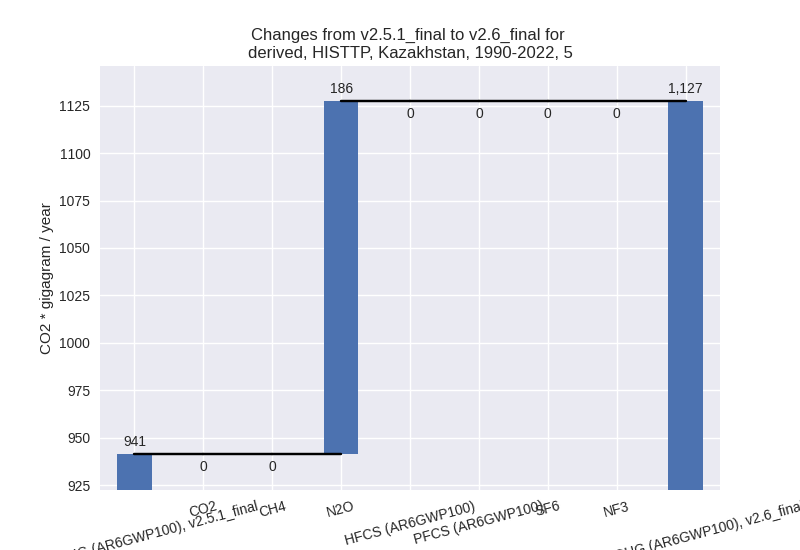Changes in PRIMAP-hist v2.6_final compared to v2.5.1_final for Kazakhstan
2024-09-24
Johannes Gütschow
Change analysis for Kazakhstan for PRIMAP-hist v2.6_final compared to v2.5.1_final
Overview over emissions by sector and gas
The following figures show the aggregate national total emissions excluding LULUCF AR6GWP100 for the country reported priority scenario. The dotted linesshow the v2.5.1_final data.
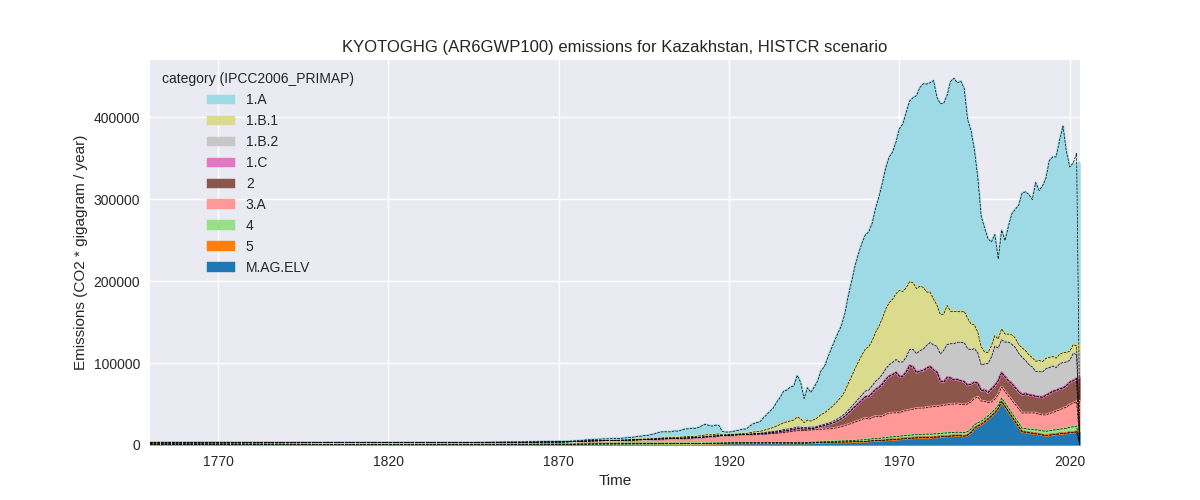
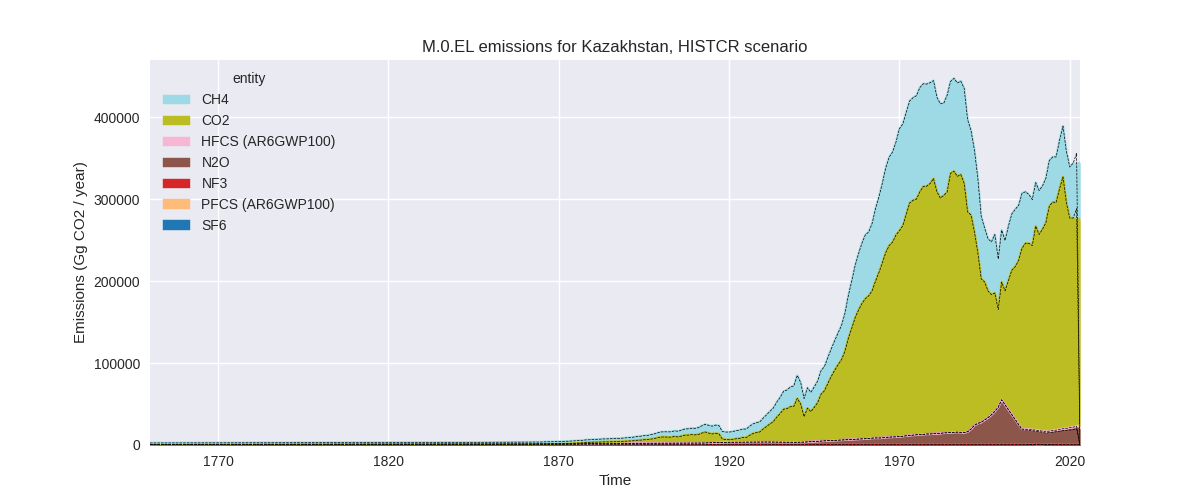
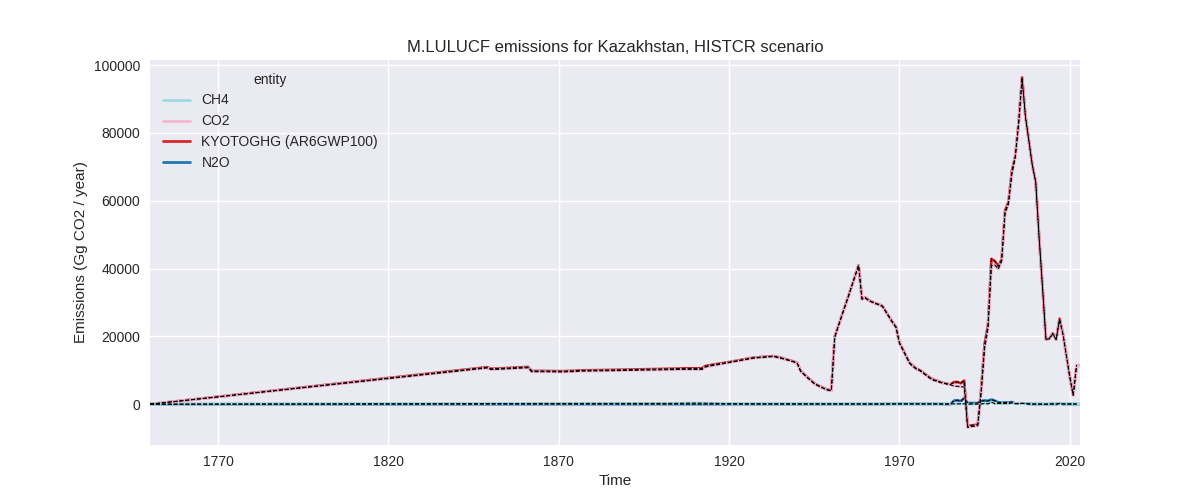
The following figures show the aggregate national total emissions excluding LULUCF AR6GWP100 for the third party priority scenario. The dotted linesshow the v2.5.1_final data.
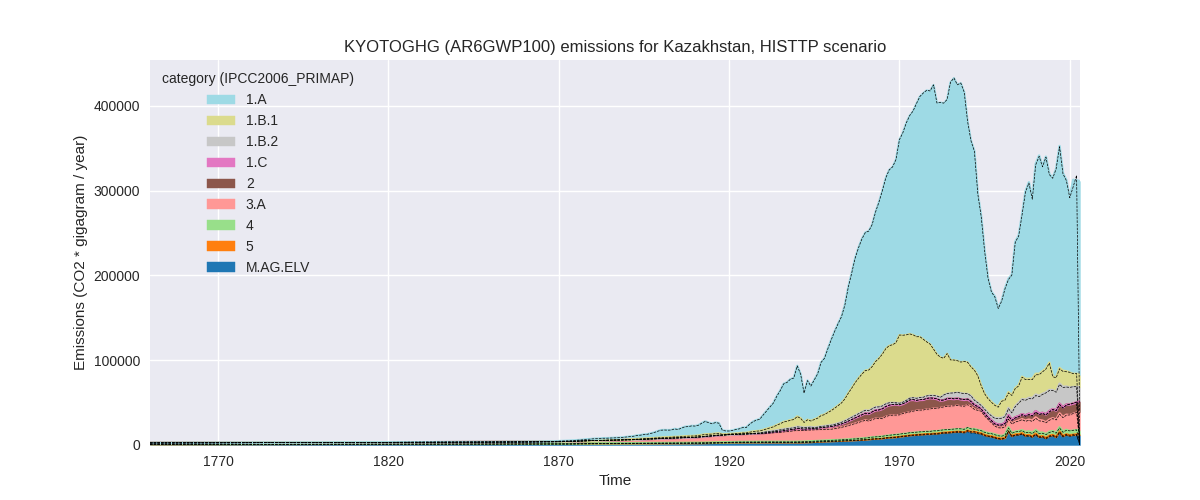
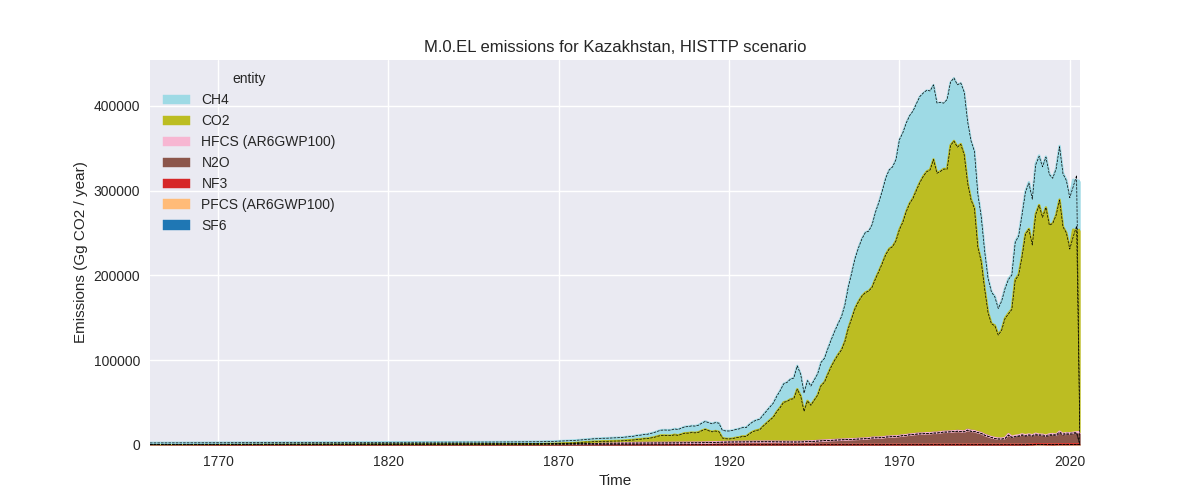

Overview over changes
In the country reported priority scenario we have the following changes for aggregate Kyoto GHG and national total emissions excluding LULUCF (M.0.EL):
- Emissions in 2022 have changed by -3.9%% (-13830.94 Gg CO2 / year)
- Emissions in 1990-2022 have changed by -0.1%% (-419.08 Gg CO2 / year)
In the third party priority scenario we have the following changes for aggregate Kyoto GHG and national total emissions excluding LULUCF (M.0.EL):
- Emissions in 2022 have changed by -1.8%% (-5772.36 Gg CO2 / year)
- Emissions in 1990-2022 have changed by 0.2%% (554.90 Gg CO2 / year)
Most important changes per scenario and time frame
In the country reported priority scenario the following sector-gas combinations have the highest absolute impact on national total KyotoGHG (AR6GWP100) emissions in 2022 (top 5):
- 1: 1.A, CO2 with -14021.56 Gg CO2 / year (-6.0%)
- 2: 1.B.2, CO2 with 133.97 Gg CO2 / year (2.1%)
- 3: 2, HFCS (AR6GWP100) with 90.90 Gg CO2 / year (2.9%)
- 4: 4, CO2 with -20.70 Gg CO2 / year (-92.4%)
- 5: 2, N2O with -13.68 Gg CO2 / year (-6.4%)
In the country reported priority scenario the following sector-gas combinations have the highest absolute impact on national total KyotoGHG (AR6GWP100) emissions in 1990-2022 (top 5):
- 1: 1.A, CO2 with -424.90 Gg CO2 / year (-0.2%)
- 2: 1.B.2, CO2 with 4.06 Gg CO2 / year (0.0%)
- 3: 2, HFCS (AR6GWP100) with 2.75 Gg CO2 / year (0.3%)
- 4: 4, CO2 with -0.63 Gg CO2 / year (-10.0%)
- 5: 2, N2O with -0.41 Gg CO2 / year (-0.6%)
In the third party priority scenario the following sector-gas combinations have the highest absolute impact on national total KyotoGHG (AR6GWP100) emissions in 2022 (top 5):
- 1: 1.A, CO2 with -5424.83 Gg CO2 / year (-2.4%)
- 2: 4, CH4 with -308.52 Gg CO2 / year (-6.2%)
- 3: 2, PFCS (AR6GWP100) with -33.96 Gg CO2 / year (-4.4%)
- 4: 1.B.2, CO2 with 33.81 Gg CO2 / year (1.7%)
- 5: 5, N2O with -27.90 Gg CO2 / year (-2.5%)
In the third party priority scenario the following sector-gas combinations have the highest absolute impact on national total KyotoGHG (AR6GWP100) emissions in 1990-2022 (top 5):
- 1: 4, CH4 with 197.80 Gg CO2 / year (5.7%)
- 2: 5, N2O with 185.88 Gg CO2 / year (19.7%)
- 3: 1.A, CO2 with 93.72 Gg CO2 / year (0.0%)
- 4: 2, PFCS (AR6GWP100) with 78.42 Gg CO2 / year (22.4%)
- 5: 1.B.2, CO2 with -5.81 Gg CO2 / year (-0.2%)
Notes on data changes
Here we list notes explaining important emissions changes for the country. ’' means that the following text only applies to the TP time series, while means that it only applies to the CR scenario. Otherwise the note applies to both scenarios.
- We have no new country reported data for Kazakhstan.
- 2022 changes in both TP and CR scenarios are mostly due to the new EI emissions estimates with some changes in subsectors due to the shorted extrapolation trend period.
- Changes in sectors 4 and 5 are due to the removal of FAOSTAT data (TP).
Changes by sector and gas
For each scenario and time frame the changes are displayed for all individual sectors and all individual gases. In the sector plot we use aggregate Kyoto GHGs in AR6GWP100. In the gas plot we usenational total emissions without LULUCF. ## country reported scenario
2022

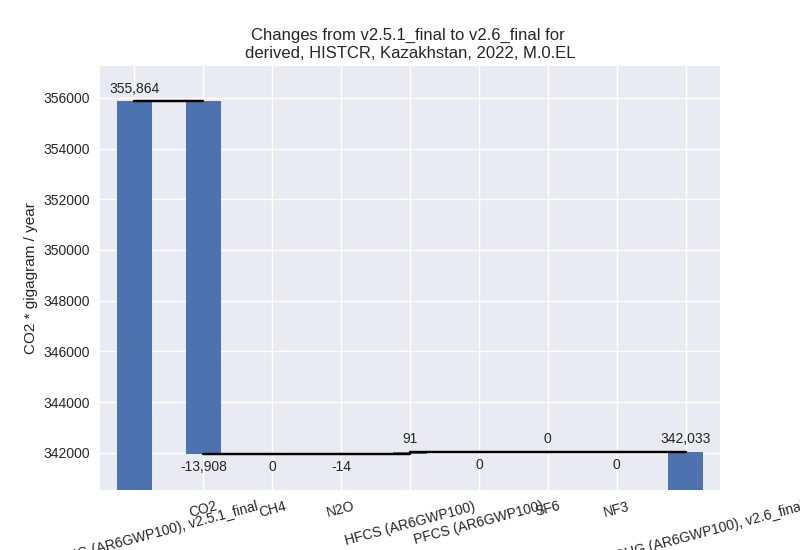
1990-2022
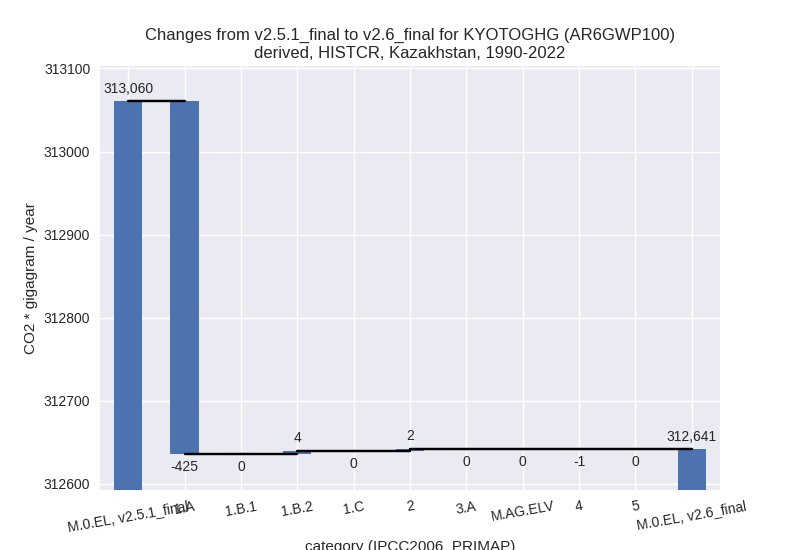
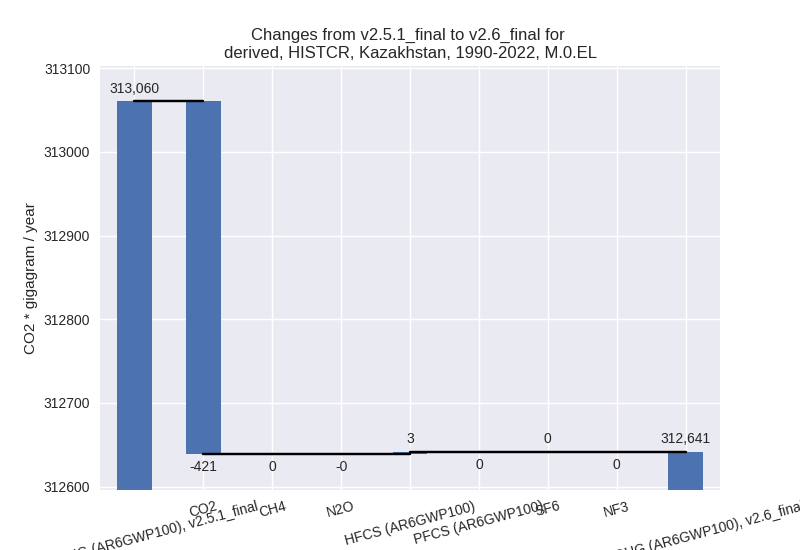
third party scenario
2022
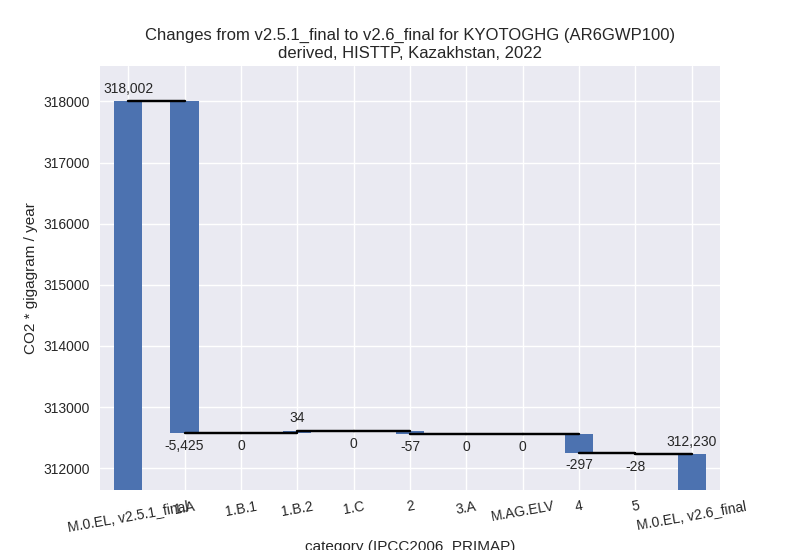
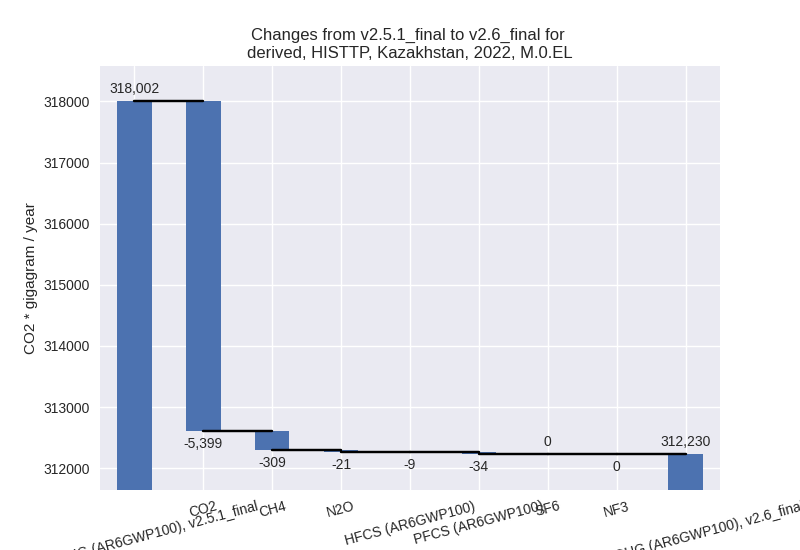
1990-2022
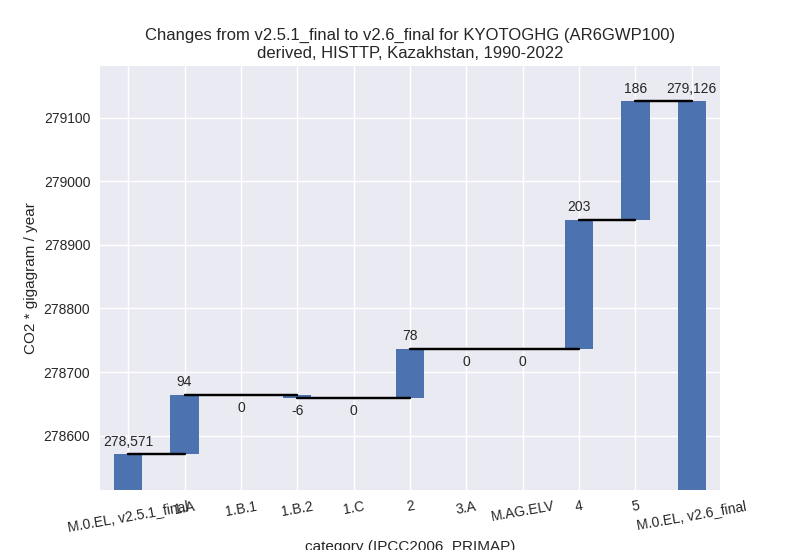
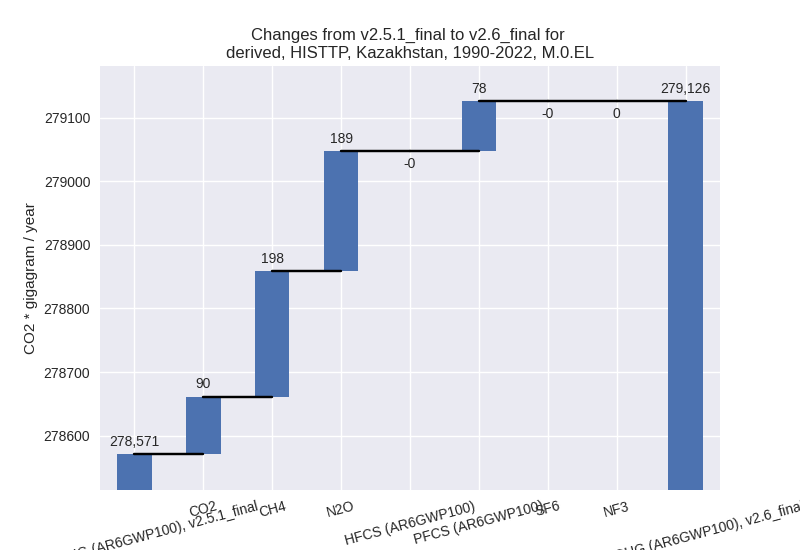
Detailed changes for the scenarios:
country reported scenario (HISTCR):
Most important changes per time frame
For 2022 the following sector-gas combinations have the highest absolute impact on national total KyotoGHG (AR6GWP100) emissions in 2022 (top 5):
- 1: 1.A, CO2 with -14021.56 Gg CO2 / year (-6.0%)
- 2: 1.B.2, CO2 with 133.97 Gg CO2 / year (2.1%)
- 3: 2, HFCS (AR6GWP100) with 90.90 Gg CO2 / year (2.9%)
- 4: 4, CO2 with -20.70 Gg CO2 / year (-92.4%)
- 5: 2, N2O with -13.68 Gg CO2 / year (-6.4%)
For 1990-2022 the following sector-gas combinations have the highest absolute impact on national total KyotoGHG (AR6GWP100) emissions in 1990-2022 (top 5):
- 1: 1.A, CO2 with -424.90 Gg CO2 / year (-0.2%)
- 2: 1.B.2, CO2 with 4.06 Gg CO2 / year (0.0%)
- 3: 2, HFCS (AR6GWP100) with 2.75 Gg CO2 / year (0.3%)
- 4: 4, CO2 with -0.63 Gg CO2 / year (-10.0%)
- 5: 2, N2O with -0.41 Gg CO2 / year (-0.6%)
Changes in the main sectors for aggregate KyotoGHG (AR6GWP100) are
- 1: Total sectoral emissions in 2022 are 261110.14
Gg CO2 / year which is 76.3% of M.0.EL emissions. 2022 Emissions have
changed by -5.1% (-13887.60 Gg CO2 /
year). 1990-2022 Emissions have changed by -0.2% (-420.84 Gg CO2 / year). For 2022
the changes per gas
are:
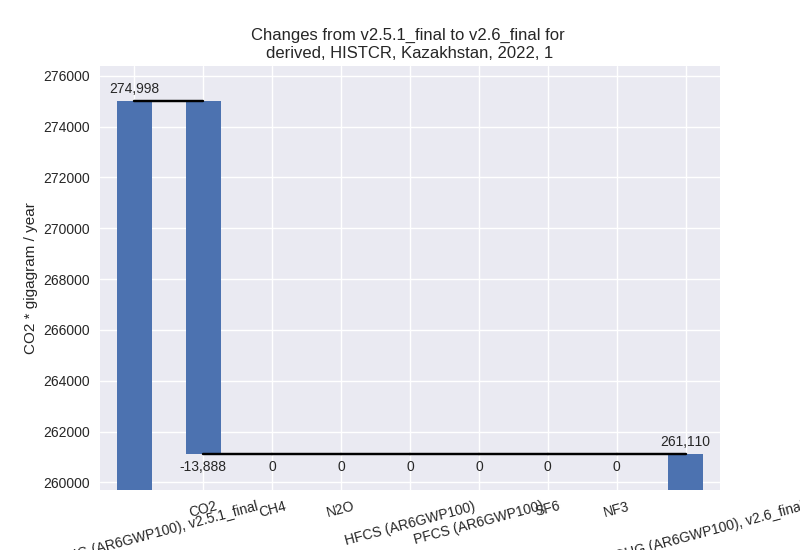
The changes come from the following subsectors:- 1.A: Total sectoral emissions in 2022 are 220705.29
Gg CO2 / year which is 84.5% of category 1 emissions. 2022 Emissions
have changed by -6.0% (-14021.57 Gg
CO2 / year). 1990-2022 Emissions have changed by -0.2% (-424.90 Gg CO2 / year). For 2022
the changes per gas
are:

There is no subsector information available in PRIMAP-hist. - 1.B.1: Total sectoral emissions in 2022 are 10757.50 Gg CO2 / year which is 4.1% of category 1 emissions. 2022 Emissions have changed by 0.0% (0.00 Gg CO2 / year). 1990-2022 Emissions have changed by 0.0% (0.00 Gg CO2 / year).
- 1.B.2: Total sectoral emissions in 2022 are 29647.35 Gg CO2 / year which is 11.4% of category 1 emissions. 2022 Emissions have changed by 0.5% (133.97 Gg CO2 / year). 1990-2022 Emissions have changed by 0.0% (4.06 Gg CO2 / year).
- 1.A: Total sectoral emissions in 2022 are 220705.29
Gg CO2 / year which is 84.5% of category 1 emissions. 2022 Emissions
have changed by -6.0% (-14021.57 Gg
CO2 / year). 1990-2022 Emissions have changed by -0.2% (-424.90 Gg CO2 / year). For 2022
the changes per gas
are:
- 2: Total sectoral emissions in 2022 are 27877.05 Gg CO2 / year which is 8.2% of M.0.EL emissions. 2022 Emissions have changed by 0.3% (77.36 Gg CO2 / year). 1990-2022 Emissions have changed by 0.0% (2.38 Gg CO2 / year).
- M.AG: Total sectoral emissions in 2022 are 46074.52 Gg CO2 / year which is 13.5% of M.0.EL emissions. 2022 Emissions have changed by 0.0% (0.00 Gg CO2 / year). 1990-2022 Emissions have changed by 0.0% (0.00 Gg CO2 / year).
- 4: Total sectoral emissions in 2022 are 6971.64 Gg CO2 / year which is 2.0% of M.0.EL emissions. 2022 Emissions have changed by -0.3% (-20.70 Gg CO2 / year). 1990-2022 Emissions have changed by -0.0% (-0.63 Gg CO2 / year).
- 5: No data
third party scenario (HISTTP):
Most important changes per time frame
For 2022 the following sector-gas combinations have the highest absolute impact on national total KyotoGHG (AR6GWP100) emissions in 2022 (top 5):
- 1: 1.A, CO2 with -5424.83 Gg CO2 / year (-2.4%)
- 2: 4, CH4 with -308.52 Gg CO2 / year (-6.2%)
- 3: 2, PFCS (AR6GWP100) with -33.96 Gg CO2 / year (-4.4%)
- 4: 1.B.2, CO2 with 33.81 Gg CO2 / year (1.7%)
- 5: 5, N2O with -27.90 Gg CO2 / year (-2.5%)
For 1990-2022 the following sector-gas combinations have the highest absolute impact on national total KyotoGHG (AR6GWP100) emissions in 1990-2022 (top 5):
- 1: 4, CH4 with 197.80 Gg CO2 / year (5.7%)
- 2: 5, N2O with 185.88 Gg CO2 / year (19.7%)
- 3: 1.A, CO2 with 93.72 Gg CO2 / year (0.0%)
- 4: 2, PFCS (AR6GWP100) with 78.42 Gg CO2 / year (22.4%)
- 5: 1.B.2, CO2 with -5.81 Gg CO2 / year (-0.2%)
Changes in the main sectors for aggregate KyotoGHG (AR6GWP100) are
- 1: Total sectoral emissions in 2022 are 262063.21
Gg CO2 / year which is 83.9% of M.0.EL emissions. 2022 Emissions have
changed by -2.0% (-5391.02 Gg CO2 /
year). 1990-2022 Emissions have changed by 0.0% (87.91 Gg CO2 / year). For 2022 the
changes per gas
are:
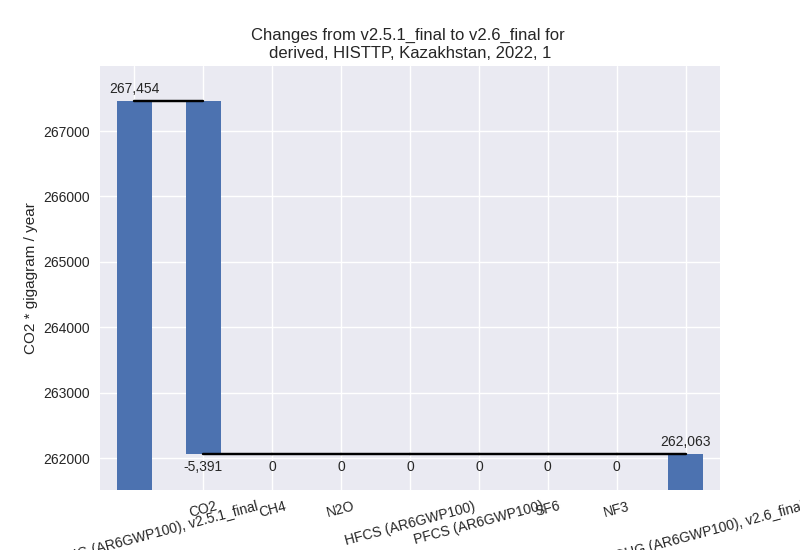
The changes come from the following subsectors:- 1.A: Total sectoral emissions in 2022 are 228226.68
Gg CO2 / year which is 87.1% of category 1 emissions. 2022 Emissions
have changed by -2.3% (-5424.82 Gg
CO2 / year). 1990-2022 Emissions have changed by 0.0% (93.72 Gg CO2 / year). For 2022 the
changes per gas
are:
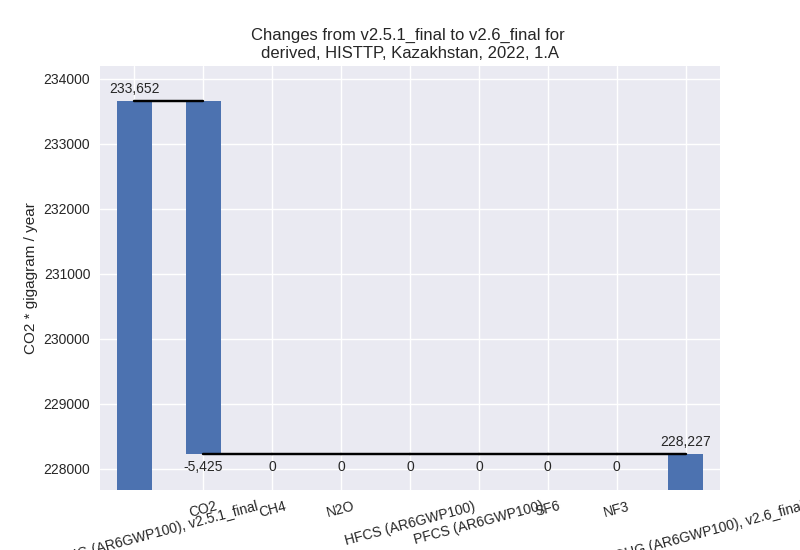
There is no subsector information available in PRIMAP-hist. - 1.B.1: Total sectoral emissions in 2022 are 15575.10 Gg CO2 / year which is 5.9% of category 1 emissions. 2022 Emissions have changed by 0.0% (0.00 Gg CO2 / year). 1990-2022 Emissions have changed by 0.0% (0.00 Gg CO2 / year).
- 1.B.2: Total sectoral emissions in 2022 are 18261.44 Gg CO2 / year which is 7.0% of category 1 emissions. 2022 Emissions have changed by 0.2% (33.81 Gg CO2 / year). 1990-2022 Emissions have changed by -0.0% (-5.81 Gg CO2 / year).
- 1.A: Total sectoral emissions in 2022 are 228226.68
Gg CO2 / year which is 87.1% of category 1 emissions. 2022 Emissions
have changed by -2.3% (-5424.82 Gg
CO2 / year). 1990-2022 Emissions have changed by 0.0% (93.72 Gg CO2 / year). For 2022 the
changes per gas
are:
- 2: Total sectoral emissions in 2022 are 12115.20 Gg CO2 / year which is 3.9% of M.0.EL emissions. 2022 Emissions have changed by -0.5% (-56.63 Gg CO2 / year). 1990-2022 Emissions have changed by 1.1% (77.64 Gg CO2 / year).
- M.AG: Total sectoral emissions in 2022 are 31967.80 Gg CO2 / year which is 10.2% of M.0.EL emissions. 2022 Emissions have changed by 0.0% (0.00 Gg CO2 / year). 1990-2022 Emissions have changed by 0.0% (0.00 Gg CO2 / year).
- 4: Total sectoral emissions in 2022 are 4985.77 Gg
CO2 / year which is 1.6% of M.0.EL emissions. 2022 Emissions have
changed by -5.6% (-296.81 Gg CO2 /
year). 1990-2022 Emissions have changed by 5.4% (203.47 Gg CO2 / year). For 2022 the
changes per gas
are:
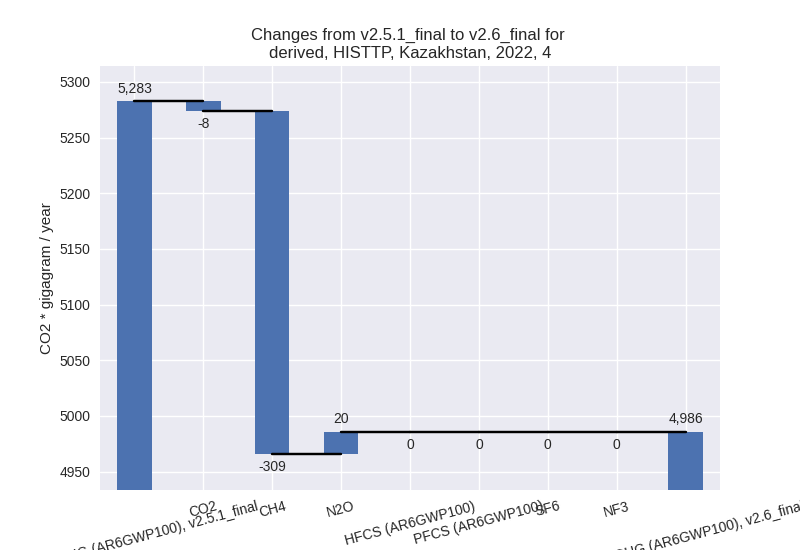
For 1990-2022 the changes per gas are: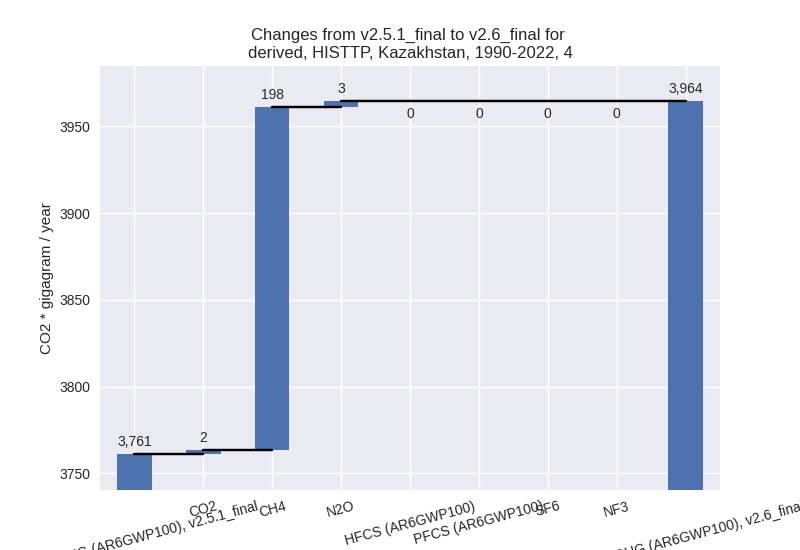
- 5: Total sectoral emissions in 2022 are 1097.75 Gg
CO2 / year which is 0.4% of M.0.EL emissions. 2022 Emissions have
changed by -2.5% (-27.90 Gg CO2 /
year). 1990-2022 Emissions have changed by 19.7% (185.88 Gg CO2 / year). For 2022 the
changes per gas
are:

For 1990-2022 the changes per gas are: